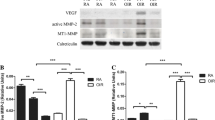Abstract
Background
We have demonstrated that macrophages/microglia were activated during post-ischemic inflammation in a mouse model of ischemic retinal neovascularization, and that the angiogenesis induced by tumor necrosis factor-α (TNF-α) appeared to be modulated through such angiogenic factors as interleukin-8 (IL-8), vascular endothelial growth factor (VEGF), and basic fibroblast growth factor (bFGF) in microvascular endothelial cells. We have extended these studies, and investigated whether TNF-α is localized in macrophages/microglia in the mouse model of retinal neovascularization, and whether TNF-α can induce angiogenic factors in retinal glial cells.
Methods
C57BL/6 J pups were placed in a 75% oxygen environment on postnatal day 7 (P7) for 5 days and then returned to room air. The co-localization of TNF-α with macrophages/microglia in the ischemic retina was examined by fluorescent immunohistochemistry. Bovine retinal glial cells were isolated for Northern blot analysis to quantify the expression levels of monocyte chemotactic protein-1 (MCP-1), IL-8, bFGF, and VEGF.
Results
Double staining of retinas revealed that the TNF-α expression level was enhanced in macrophages/microglia 4 days after the hypoxia. Cellular mRNA levels of MCP-1, IL-8, and bFGF, but not VEGF, were increased after treating retinal glial cells with TNF-α (100 U/ml).
Conclusions
The results indicate that TNF-α is produced by activated macrophages/microglia and may participate in retinal neovascularization during post-ischemic inflammation through the induction of potent angiogenic factors in an autocrine or paracrine manner.


Similar content being viewed by others
References
Adamis AP (2002) Is diabetic retinopathy an inflammatory disease? Br J Ophthalmol 86:363–365
Armstrong D, Augustin AJ, Spengler R, Al-Jada A, Nickola T, Grus F, Koch F (1998) Detection of vascular endothelial growth factor and tumor necrosis factor alpha in epiretinal membranes of proliferative diabetic retinopathy, proliferative vitreoretinopathy and macular pucker. Ophthalmologica 212:410–414
Crowther M, Brown NJ, Bishop ET, Lewis CE (2001) Microenvironmental influence on macrophage regulation of angiogenesis in wounds and malignant tumors. J Leukoc Biol 70:478–490
Eichler W, Yafai Y, Kuhrt H, Grater R, Hoffmann S, Wiedemann P, Reichenbach A (2001) Hypoxia: modulation of endothelial cell proliferation by soluble factors released by retinal cells. Neuroreport 12:4103–4108
Elner SG, Elner VM, Jaffe GJ, Stuart A, Kunkel SL, Strieter RM (1995) Cytokines in proliferative diabetic retinopathy and proliferative vitreoretinopathy. Curr Eye Res 14:1045–1053
Elner SG, Strieter RM, Elner VM, Rollins BJ, Del Monte MA, Kunkel SL (1991) Monocyte chemotactic protein gene expression by cytokine-treated human retinal pigment epithelial cells. Lab Invest 64:819–825
Limb GA, Chignell AH, Green W, LeRoy F, Dumonde DC (1996) Distribution of TNF alpha and its reactive vascular adhesion molecules in fibrovascular membranes of proliferative diabetic retinopathy. Br J Ophthalmol 80:168–173
Limb GA, Hollifield RD, Webster L, Charteris DG, Chignell AH (2001) Soluble TNF receptors in vitreoretinal proliferative disease. Invest Ophthalmol Vis Sci 42:1586–1591
Low QE, Drugea IA, Duffner LA, Quinn DG, Cook DN, Rollins BJ, Kovacs EJ, DiPietro LA (2001) Wound healing in MIP-1alpha(-/-) and MCP-1(-/-) mice. Am J Pathol 159:457–463
Majka S, McGuire PG, Das A (2002) Regulation of matrix metalloproteinase expression by tumor necrosis factor in a murine model of retinal neovascularization. Invest Ophthalmol Vis Sci 43:260–266
Pierce EA, Avery RL, Foley ED, Aiello LP, Smith LE (1995) Vascular endothelial growth factor/vascular permeability factor expression in a mouse model of retinal neovascularization. Proc Natl Acad Sci USA 92:905–909
Salcedo R, Ponce ML, Young HA, Wasserman K, Ward JM, Kleinman HK, Oppenheim JJ, Murphy WJ (2000) Human endothelial cells express CCR2 and respond to MCP-1: direct role of MCP-1 in angiogenesis and tumor progression. Blood 96:34–40
Spranger J, Meyer-Schwickerath R, Klein M, Schatz H, Pfeiffer A (1995) TNF-alpha level in the vitreous body. Increase in neovascular eye diseases and proliferative diabetic retinopathy. Med Klin 90:134–137
Sunderkotter C, Steinbrink K, Goebeler M, Bhardwaj R, Sorg C (1994) Macrophages and angiogenesis. J Leukoc Biol 55:410–422
Yoshida A, Yoshida S, Hata Y, Khalil AK, Ishibashi T, Inomata H (1998) The role of NF-kappaB in retinal neovascularization in the rat. Possible involvement of cytokine-induced neutrophil chemoattractant (CINC), a member of the interleukin-8 family. J Histochem Cytochem 46:429–436
Yoshida A, Yoshida S, Ishibashi T, Inomata H (1999) Intraocular neovascularization. Histol Histopathol 14:1287–1294
Yoshida A, Yoshida S, Ishibashi T, Kuwano M, Inomata H (1999) Suppression of retinal neovascularization by the NF-kappaB inhibitor pyrrolidine dithiocarbamate in mice. Invest Ophthalmol Vis Sci 40:1624–1629
Yoshida A, Yoshida S, Khalil AK, Ishibashi T, Inomata H (1998) Role of NF-kappaB-mediated interleukin-8 expression in intraocular neovascularization. Invest Ophthalmol Vis Sci 39:1097–1106
Yoshida S, Ono M, Shono T, Izumi H, Ishibashi T, Suzuki H, Kuwano M (1997) Involvement of interleukin-8, vascular endothelial growth factor, and basic fibroblast growth factor in tumor necrosis factor alpha-dependent angiogenesis. Mol Cell Biol 17:4015–4023
Yoshida S, Yoshida A, Ishibashi T, Elner SG, Elner VM (2003) Role of MCP-1 and MIP-1alpha in retinal neovascularization during postischemic inflammation in a mouse model of retinal neovascularization. J Leukoc Biol 73:137–144
Yoshida S, Yoshida A, Matsui H, Takada Y, Ishibashi T (2003) Involvement of macrophage chemotactic protein-1 and interleukin-1beta during inflammatory but not basic fibroblast growth factor-dependent neovascularization in the mouse cornea. Lab Invest 83:927–938
Yossuck P, Yan Y, Tadesse M, Higgins RD (2001) Dexamethasone alters TNF-alpha expression in retinopathy. Mol Genet Metab 72:164–167
Author information
Authors and Affiliations
Corresponding author
Rights and permissions
About this article
Cite this article
Yoshida, S., Yoshida, A. & Ishibashi, T. Induction of IL-8, MCP-1, and bFGF by TNF-α in retinal glial cells: implications for retinal neovascularization during post-ischemic inflammation. Graefe's Arch Clin Exp Ophthalmol 242, 409–413 (2004). https://doi.org/10.1007/s00417-004-0874-2
Received:
Revised:
Accepted:
Published:
Issue Date:
DOI: https://doi.org/10.1007/s00417-004-0874-2




